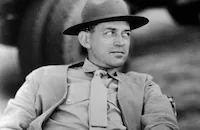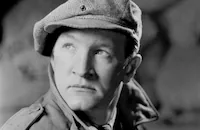Eskimo

Brief Synopsis
Cast & Crew
W. S. Van Dyke
Mala
Lotus
Joseph Sauers
W. S. Van Dyke
Peter Freuchen
Film Details
Technical Specs

Synopsis
When Mala, the best hunter in his remote Eskimo village, hears tales from other tribesmen about the White Man's ship and the guns that the White Man trades for fox skins, he is greatly impressed. Later Mala's wife Aba, who longs for the White Man's goods, suggests that Mala and their family travel to the ship, and Mala, who is concerned about providing food for the long winter, agrees. After a 500 mile journey across the frozen tundra, during which Mala graciously offers Aba's sexual services to a womanless hunter, Mala and his family arrive at Tjaranak, an inlet where the White Man's ship is harbored. Mala barters with the unscrupulous captain of the ship and trades his valuable skins for a rifle. Taken with Aba, the captain then insists she remain with him and seduces her with alcohol and useless gifts. The next day, an angry Mala forces the captain to promise to leave Aba alone while he and a group of men are away whale hunting. Later, the sailors begin to drink, and the captain orders two of his men to bring Aba to the ship. Dragged from her igloo against her will, Aba is forced to drink and is raped by the captain. The next morning, still drunk, she stumbles from the ship and collapses in the snow, where she is mistaken for an animal and is shot by a sailor. When Mala returns from the whale hunt, he is told that his wife "sleeps" and learns about the circumstances of her death. Enraged, he kills the captain with a harpoon and rushes back to his tribe with his children. Back in his village, Mala grieves for Aba but leads his tribesman in a successful caribou hunt. While staring at a slain caribou, however, Mala sees the image of the captain and consults with a Wise Old One about his vision. The Wise Old One advises him to ask the Spirits for a new name, so that the captain cannot follow him, and Mala goes to a sacred hilltop to pray. Inspired by a bird that flies overhead, Mala takes the name Kripik and begins to dance and chant. He then notices that Iva, the second wife of another hunter, has followed him and reveals to her his new name. With his new identity, Mala warms to Iva, who has always loved him and has been offered to him by her husband, and agrees to "lie down" with her. Out of respect for Mala, the other hunter offers him his first wife as well and announces that he is leaving the village for good. While Mala enjoys his new family, a Royal Canadian Mounted Police post is established in the Tjaranak inlet, and after the two Mounties in charge learn of the captain's killing, they set out to find and arrest Mala. Near his village, Mala comes across the nearly frozen bodies of the Mounties and reluctantly takes them to his igloo. After they recover sufficiently, the Mounties question Mala about his identity and, through their English speaking Eskimo guide, learn that he is the captain's killer. Although grateful to Mala, the Mounties trick him into leaving his family by telling him that they need his help in securing food at the inlet. While Mala is out wolf hunting for the post, Inspector White arrives and demands that Mala be treated like a prisoner. Reluctantly the Mounties tell Mala, who has learned that his family is alone and starving in the village, that he cannot go home and, breaking a promise they made to him, shackle him to his bed. Enduring great pain and injury, Mala wriggles his hand out of the shackle and, with his dog team, escapes before daylight. The Mounties dutifully pursue him, aware that with his injured hand his chances of a successful flight are limited. After a grueling journey, Mala finally is rescued by his eldest son near his deserted village. Determined not to be re-captured by the traitorous white men, Mala announces that he is leaving the family but is followed by the loyal Iva. As they head for an ice floe, Mala and Iva are pursued by the approaching Mounties. Unable to stop Mala without shooting him, the Mounties decide at last to give the brave Eskimo his freedom.

Director

W. S. Van Dyke
Cast

Mala

Lotus

Joseph Sauers

W. S. Van Dyke
Peter Freuchen
Edgar Dearing
Harold Seabrook
Crew
Roy Clark
Clyde De Vinna
Dale Deverman
Edward Hearn
William James Knott
John Lee Mahin
Frank Messenger
Conrad A. Nervig
George Nogle
Emil Ottinger
C. S. Pratt
Josiah Roberts
Leonard Smith
Hunt Stromberg
W. S. Van Dyke
H. D. Watson

Photo Collections
Videos
Movie Clip



Trailer
Film Details
Technical Specs

Award Wins
Best Editing
Articles
Eskimo
W. S. Van Dyke made a name for himself at MGM in the late twenties as a director whose forte was making dramatic adventure stories enhanced by exotic documentary footage using real locations and local natives. His 1929 feature, White Shadows in the South Seas enjoyed considerable controversy at the time because the original director, documentarian Robert Flaherty, was fired midway through production after constantly clashing with studio executives over the film's original intent. Van Dyke stepped in to complete the film, transforming Flaherty's ethnographic study of the Marquesas Islands in the South Pacific into a scenic melodrama about a alcoholic doctor (Monte Blue) and his love for a native girl (Raquel Torres). Despite the on-location production problems on White Shadows in the South Seas, Van Dyke headed back to the South Seas to film The Pagan with Ramon Novarro in 1929. Then, in 1930, the director traveled with a cast and crew to Africa to shoot Trader Horn (1931) which was also plagued by bad luck and accidents; the sound equipment truck became submerged in a river, the female lead, Edwina Booth, fell ill in the tropical heat, and Harry Carey, the hero of the film, almost lost his leg to a crocodile. Van Dyke was later able to recycle some of his African jungle footage for Tarzan, the Ape Man (1932), the first in a long line of Edgar Rice Burroughs adaptations starring Johnny Weissmuller.
In 1932, Van Dyke set out to make Eskimo (1933), hyped by MGM as his most ambitious project to date. It was no less arduous to film than his previous expeditions to some of the world's most remote locales. Taking a camera crew to the northern tip of Alaska, Van Dyke arrived at his shooting location during the winter of 1932-33. Weather conditions were harsh and Van Dyke's ship was soon rendered immobile by the heavy ice. Luckily, their guide, Peter Freuchen (his many books on Eskimo culture served as the basis for John Lee Mahin's screenplay), helped the crew deal with the local natives and capture some stunning landscapes and hunting footage involving walrus, caribou and a polar bear. At times Eskimo resembles a documentary with its remarkable scenes of salmon spear fishing or husky sled-teams traveling across the ice. Also adding a sense of authenticity was Van Dyke's insistence on having all of the Eskimos speak in their own dialect, which is often translated on-screen via subtitles or a narrator.
Eskimo does not open with standard movie credits. Instead, it has an introduction stating that no actors were used in the film (except for the roles of the white traders and the Royal Mounted Canadian Police). Despite Van Dyke's claim that all of the Eskimos were played by tribal people from the Arctic region, Mala and Lotus Long, cast respectively as Mala and Iva (one of Mala's wives in the film), were actually professional actors. Mala, in fact, would go on to enjoy a successful Hollywood career, playing variations on his innocent native in Last of the Pagans (1935), Call of the Yukon (1938), and The Tuttles of Tahiti (1942).
Unfortunately, Eskimo was not a success at the box office. Perhaps moviegoers at the time didn't have the same curiosity about the Arctic that they did about the Pacific Rim or Africa. But most likely it was the depressing storyline that discouraged ticket buyers. Though it occasionally veers off into melodramatic excess, Eskimo is an often powerful indictment of white civilization and its destructive impact on indigenous cultures. Mala's performance as the victimized main character is genuinely moving and the film has a classic structure not unlike the great stage tragedies of Shakespeare. Despite favorable reviews, Eskimo was overlooked at Oscar time, except in one category - Best Film Editing - for which it won an Academy Award.
Producers: Hunt Stromberg, W.S. Van Dyke
Director: W.S. Van Dyke
Screenplay: John Lee Mahin based on the novels of Peter Freuchen
Cinematography: Clyde De Vinna, George Gordon Nogle, Josiah Roberts, Leonard Smith
Film Editing: Conrad A. Nervig
Original Music: William Axt
Cast: Edgar Dearing (Constable Balk), Mala (Mala), Lotus Long (Iva), Edward Hearn (Captain's Mate), Joe Sawyer (Sergeant Hunt), W.S. Van Dyke (Inspector White), Peter Freuchen (Captain).
BW-114m. Closed captioning.
by Jeff Stafford

Eskimo
Quotes
Trivia
Notes
The onscreen credits contain the following statement: "The Expedition to the Arctic began in April 1932...In November of 1933, the record was complete. Excepting the characters of the Canadian Police, there are no actors in this record...entire story told by primitive Eskimos in Native tongue, in Native custom...The Books by Peter Freuchen were notable for their discussion of the Moral Code of the Eskimos...this record attempts to present that Code...a strong, primeval Creed belonging to the farthest wilderness of the endless North...." Sub-titles were used in the film to translate Eskimo dialogue. In spite of the film's "no actor" claims, the Eskimo performers appear to be well-trained and "made up" for their parts. An unidentified contemporary source in the AMPAS files states that Mala, a genuine Eskimo, came to Los Angeles a year or two before the production began to work as a cameraman. Originally hired as a guide for Eskimo, he convinced the filmmakers of his acting talent and was cast in the lead. According to modern sources, producer Hunt Stromberg was so impressed with Mala's performance in the film that he signed him to an M-G-M contract. In his later films, Mala usually portrayed Polynesian characters. Lotus also made her screen debut in this film. She later changed her name to Lotus Long and, like Mala, played Asian characters.
A late July 1932 Hollywood Reporter news item announced that location shooting for the production had begun in the Arctic. According to an informal production newsletter, which was edited by author Peter Freuchen, the film crew had its camp in Teller, AK. An October 1932 Hollywood Reporter news item claimed that the Eskimo crew was "iced in" during shooting and had to be rescued by a dog sled team. Film Daily news items indicate that Van Dyke completed the direction of the film in May 1933, and that other members of the crew, including still photographer Roy Clark, returned from the Arctic in April 1933, after a ten-month stay. The location camp chef, Emil Ottinger, was hired from the kitchen of the Roosevelt Hotel in Hollywood, according to an unidentified contemporary source found in the AMPAS files. The same source also noted that the production cost $1.5 million and employed forty-two cameramen and technicians and six airplane pilots.
The film's preview running time was 160 minutes, indicating that a large amount of footage was cut for the final release prints. According to a Hollywood Reporter news item, Freuchen spent several weeks lecturing throughout the country in connection with the film's opening. Conrad Nervig won an Academy Award for Best Editing for his work on the production. Modern sources add Edward Hearn as "the Captain's mate" to the cast. Hearn was an assistant director on the production.















